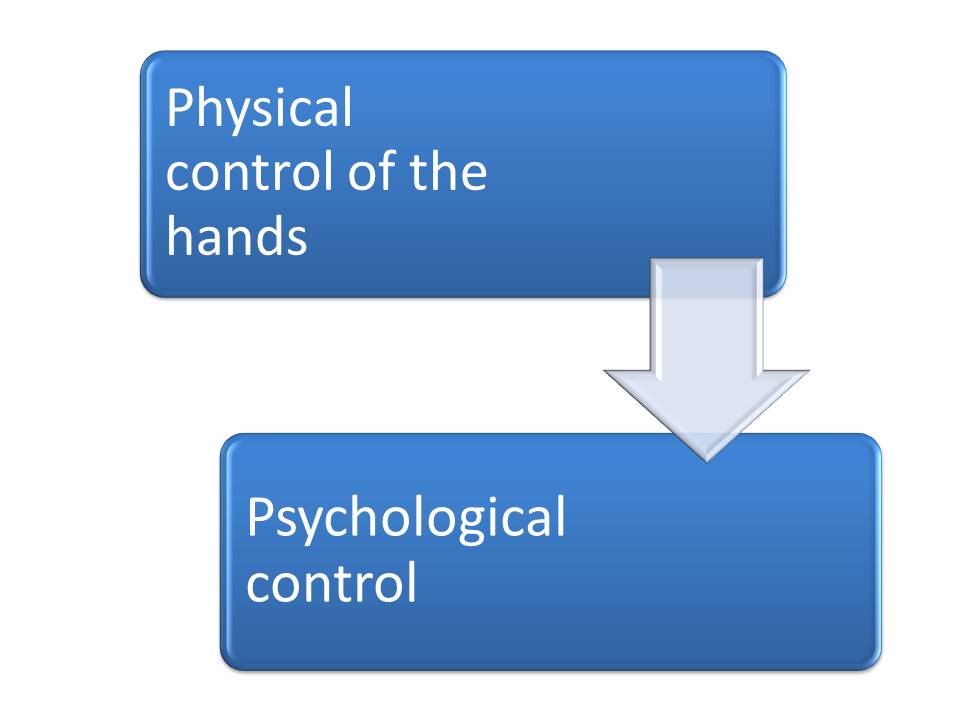The ‘wringing hands’ body language gesture is where a person squeezes one hand with the other repeatedly or alternately, or both. Usually, the knuckles of one hand get pressed between the palm and the fingers of the other hand.
Other times, the person rubs their entire hand as if they were washing it. In other cases, only individual fingers are rubbed.

The person usually has one or both hands in a cupped position when they do this gesture. Other times, their hands might be clasped together with interlaced fingers.
This gesture shouldn’t be confused with rubbing palms together back and forth repeatedly, which shows excitement or positive expectation.
Wringing hands meaning
This gesture is done by a person who’s feeling uncomfortable. Stress, nervousness, frustration, or anxiety may be behind the discomfort. Usually, it’s anxiety.
It’s a self-pacifying gesture aimed at restoring a sense of control and comfort. It’s as if the person is trying to say “It’ll be okay” to themselves.
Since anxiety is the common reason behind this gesture, we can expect to observe this gesture in anxiety-provoking situations. And anxiety is often triggered when we’re waiting for something that’s important to us.
Imagine a person waiting outside the operation theatre in a hospital. Their loved one is being operated on inside the theatre. As they wait anxiously outside, they might keep wringing their hands.
Other such anxiety-provoking ‘waiting’ situations where this gesture is likely to occur are:
- A patient waiting in the dentist’s room
- A person waiting for their date
- A student waiting for their turn to speak
- A student waiting to answer a tough question in a viva exam
Anxiety is accompanied by a loss of control. The person cannot control the outcome of an important, impending event. So they restore some degree of control through the wringing motion. They can control the amount of pressure they apply to their hand and when.
This makes the gesture an effective means to feel in control in the face of uncontrollable situations.

Another situation where this gesture is commonly observed is when a person faces a difficult problem or has to make an important decision. Lots of anxious thinking and hand-wringing often precede important decisions.
This gesture may also indicate self-restraint. For example, when a person is angry, they might control their anger for a while by wringing their hands. When they’ve had enough, they might finally get aggressive at their source of anger.
Hand-wringing may also be done when a person is feeling cold. It’s also associated with a medical condition called Rett syndrome. Of course, our focus here is on body language but you should seek to eliminate those explanations when interpreting this gesture.
Accompanying gestures
When reading body language, one must try their best not to jump to a conclusion based on a single gesture. Instead, one ought to look at gesture clusters.
Often, an emotional state will have its own gesture cluster. Anxiety, for example, leads not only to wringing of the hands but also other gestures such as nail-biting and hand or feet tapping.
To confirm that a person wringing their hands is indeed feeling anxious, you can look for these other signs.
A distressed person wringing their hands will often look down and scratch their nose (negative evaluation). They may also walk back and forth restlessly while they wait.
When fingers are interlaced, this gesture creates a barrier in front of the upper body, signaling defensiveness.
The person may alternate between wringing their hands and adopting a full-on arms-crossed gesture.
Watch the woman in this scene do the hand-wringing gesture when she hears something discomforting or something she disapproves of. Her furrowed brows and sideways look add to her disapproval as if she were saying:
“What the hell are you talking about?”
The ‘hand-wringing’ expression
Body language gestures often make their way into verbal communication. For example:
“He raised his eyebrows upon hearing the sales pitch.”
“Wherever she goes, she makes heads turn.”
We understand the meaning of these phrases because we can picture people doing these gestures in various situations.
‘Hand-wringing’ is also one such verbal expression borrowed from the world of body language. ‘Hand-wringing’ as an expression means:
Showing fake distress or vacillating in the face of a crisis.
When you’re hand-wringing about an issue, you’re spending too much time showing you’re worried about it but not doing anything. The worry is fake and you’re probably unwilling to act.
An example of how this phrase is used:
“Time for hand-wringing about corruption is over: the government has to act now!”
